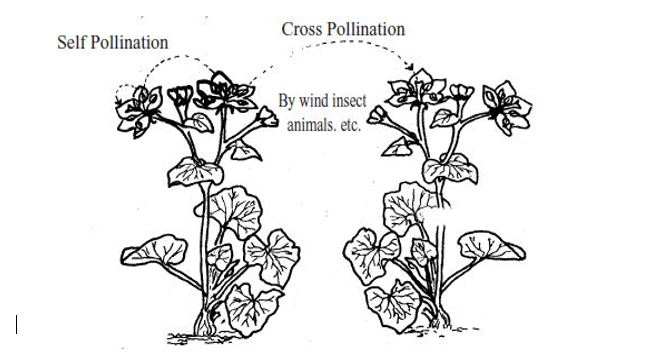Back to: BIOLOGY SS2
Welcome to Class !!
We are eager to have you join us !!
In today’s Biology class, We will be learning about Pollination. We hope you enjoy the class!

CONTENT
- Definition
- Pollination in plants
- Features of self and cross-pollinated flowers
- Agents of pollination
DEFINITION
This is the transfer of mature pollen grains from the anther of one flower to the mature stigma of the same or another flower of the same plant or another plant of closely related species. Pollination usually precedes fertilization. There are two types of pollination namely; self-pollination and cross-pollination
SELF POLLINATION
This is the transfer of mature pollen grain from the anther of a flower to the stigma of the same flower or to that of another flower of the same plant e.g. tomato and pear. Therefore, self-pollination involves only one parent plant i.e. bisexual flowers or monoecious plants
CROSS POLLINATION
This is the transfer of mature pollen grains from the anther of a flower to the stigma of a flower on another plant of the same or closely related species e.g. hibiscus, pawpaw. Therefore cross-pollination involve two parent plants i.e. unisexual flowers or dioecious plants. Cross-pollination depends on external agents like wind, insect etc.

ADVANTAGES OF SELF POLLINATION
- It ensures effective pollination in bisexual flowers
- It avoids wastage of pollen grains
DISADVANTAGES OF SELF POLLINATION
- Production of weak offspring due to continuous self-pollination
- The offspring are less adaptive to the environment.
ADVANTAGES OF CROSS POLLINATION
- Production of healthier offspring.
- Production of viable seeds
- The offspring are more adapted to the environment
- Formation of new varieties with good characteristics
DISADVANTAGES OF CROSS POLLINATION
- It depends on external agents e.g. wind and insect
- It leads to wastage of pollen grain, especially in wind pollination.
EVALUATION
- What is pollination?
- Differentiate between self and cross-pollination
FEATURES OF SELF POLLINATED FLOWERS
Features favouring self-pollination include
- Homogamy: This is the ripening of anther and stigma of bisexual flower at the same time
- Cleistogamy: This is when ripe pollen grains are deposited on the stigma which then becomes ripened at the same time.
FEATURES OF CROSS POLLINATED FLOWERS
- Dioecious flowers: When male and female flowers occur on separate plant e.g. pawpaw
- Dichogamy: When male and female parts mature at different times. Dichogamy can be
- protandry: when anther matures or ripens before the stigma e.g. sunflower, okro and cotton
- protogyny when stigma matures before anther e.g. palms and figs.
- Possession of brightly coloured petals to attract insect e.g. hibiscus.
- Possession of sweet smell for attracting insects e.g. rose flower.
- Unisexual flowers
- Self-incompatibility
- Position of anthers and stigmas
EVALUATION
- What are the features of cross-pollinated flowers?
- Define the terms (a)homogamy (b)cleistogamy (c)dichogamy.
AGENTS OF POLLINATION
Agents of pollination (pollinators) are the organisms which help in the transfer of pollen grains from the anther to the stigma of flowers. This pollinator includes: insects, birds, snails, bats and man and also physical factors like wind and water.
The two major agents of pollination are:
- insects
- wind
Flowers pollinated by them are marked with certain features that will be stated below
CHARACTERISTICS OF INSECT POLLINATED FLOWERS (ENTOMOPHILOUS)
- Large conspicuous petals and sepals
- Bright colouration
- Possession of scent
- Presence of nectars.
- Presence of rough, sticky and relatively few pollen grains
- Flat, sticky stigma to receive pollen grains.
Entomophilous flowers include hibiscus, crotalaria, the pride of Barbados, etc.
CHARACTERISTICS OF WIND POLLINATED FLOWER (ANAEMOPHILOUS FLOWER)
- Small inconspicuous petals and sepals
- Dull coloured flowers
- Absence of scent
- Absence of nectars
- A large quantity of pollen grains
- Pollen grains are small, lightened sticky
- Elongated sticky stigma with a large surface area.
Examples include cereals like maize, guinea corn and rice
GENERAL EVALUATION
- What is pollination
- Explain what you understand by self and cross-pollination.
- What are the features of self and cross-pollination?
- State five characteristics of entomophilous and anemophilous flowers.
- What are the agents of pollination?
READING ASSIGNMENT
College Biology, chapter 16, page 333 – 348
WEEKEND ASSIGNMENT
SECTION A
- Which of these is not condition for cross-pollination A. protandry B. protogyny C. homogamy D. self-incompatibility
- The following are entomophilous flowers except A. hibiscus B. crotalaria C. maize flower D. pride of Barbados
- Courtship behaviours in animals include the following except A. display B. migration C. pairing D. adaptation
- Which of these is not a type of courtship display in animals croaking in toad B. colour change in chameleon C. bright colour feather in peacock D. singing in human being
- The following are advantages of cross-pollination except A. wastage of pollen grains B. production of viable seeds C. leads to varieties of offspring D. offspring are more adapted to the environment
SECTION B
- Differentiate between entomophilous and anemophilous flower
- Outline four features that favour cross-pollination
We have come to the end of this class. We do hope you enjoyed the class?
Should you have any further question, feel free to ask in the comment section below and trust us to respond as soon as possible.
In our next class, we will be learning about Ecological Succession. We are very much eager to meet you there.
